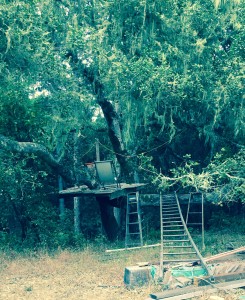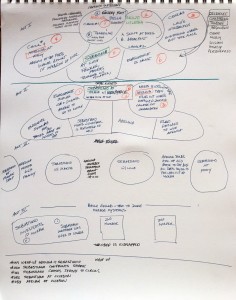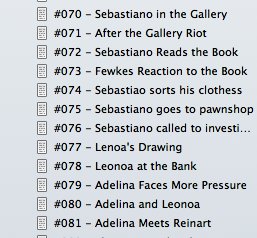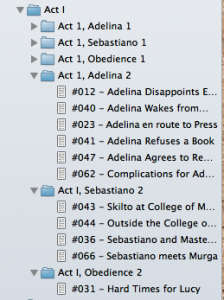

So, what’s the difference between taking one of my live online writing classes and the on-demand versions? Let’s look at the cons first:
Pros, on the other hand?
...
Yesterday I got very little writing done, and instead worked on plotting. Ugh. I’ve reached that stage of the manuscript where I feel like I’m herding cats, and it seemed like time to make things make more sense.
Major Ingredients for Plotting
In starting, I had the following:
And some things that made the process of plotting more complicated:
Figuring Out the Overall Structure: the Sketchbook Method
So I printed out the synopsis and got out my big sketchpad. I wrote the three chronological points that were most important from the first book on the page, roughly where I thought they’d fall in the book: one at the very beginning, one about a quarter way through, and one about half the way through.
At first I divided the page into three sections for three acts, but by the time I was done, there were five sections total. I think of them as “acts” in that I want them to begin at an interesting point, have the right mix of scenes from the different POVs, and finish in a way that feels like a mini-ending, a chance to think about what’s gone before and to prepare for what’s coming up.

As you can see, that first page eventually ended up looking like a bit of a mess (and right now the image keeps showing up sideways, for some inexplicable reason that I cannot figure out at the moment), but it let me figure out where some things had to happen and realize that I had to nail down where a particular character from the first book is at all times.
I started working with colored pencils in order to track the different main characters, but that fell away as I began arranging what I already had. But it’s handy to be able to see the story from a high altitude, the 10,000 foot view, so to speak, particularly in terms of making the story make sense. Because while the writer can — and probably should deviate from a straightforward chronology for anything but the least complicated of stories — every time they do it, they place a demand on the reader to jump the hurdle and bounce along into the next scene with them.
As far as what’s been written, I have it in Scrivener, that most indispensable of tools. My process lately has been to work on individual scenes in nothing at all like chronological order, but more in the order of ones that really will be fun to write first (this approach has the drawback of inevitably arriving at a final sludge of scenes you didn’t want to write, but you will find at that point that at least half of them are actually not necessary.) So I began splitting up the pieces that were actually multiple scenes crammed in one document because they’d all been part of the same writing sprint, and numbering each one.

Breaking Things Down: Individual Acts
Taking my big sheet, I created a new one for each of the first four sections, and with each, tried to figure out the structure as far as the alternating voices went. I realized that what I had were two main points of view (Adelina and Sebastiano) and then a third one consisting of a brother and a sister (Eloquence and Obedience).
As I went through the manuscript, I began to sort the scenes into order, creating folders for the different POVs. While the scenes may not happen in the exact order they do in the folder, this gets me started putting scenes that will be close together into a single chunk.

Here are the individual act pages. As you can see, they’re messy and inexact, but they’re helping me sort out what goes where in a way that will then let me compile what I have into a document and start looking for the major holes, since filling them in is the next step.
Once I have those holes filled in, I’ll begin wrestling each chunk into a smooth form, and imposing a story arc of one kind or another on it.
Someone asked how I use Tarot cards in plotting. I use them as a way to figure out the major points and considerations for a scene or a chunk, by doing a simple Celtic Cross reading for the main character in that scene. If you’re not familiar with Tarot cards and that configuration for reading them, here’s better information on the spread, and I’ll blog sometime in the next couple days with a sample reading for a scene (but right now I should put in some actual ficiton wordcount).
Some SFWA and Class-related Stuff
In SFWA news, Todd Vandemark has put up the 1st of the videos he filmed at this year’s Nebulas, Steven Gould and I talking about joining SFWA. There will be new content on the channel released on a regular basis throughout the coming year, and I’m pleased to see that idea finally taking solid form.
Maggie Hogarth is onboard as the new Vice President and already hard at work. Look for some cool stuff coming up over the new year. 🙂
Finally, I’ve been doing some teaching from retreat and finding out that the wireless works fine. The Writing Your Way Into Your Novel class was terrific and gave me lots of ideas. This Saturday the 6 week Writing F&SF Stories starts. I’ve still got slots in that (as well as most of the other classes) and would be willing to talk about sliding scale or barter if you’re interested. If you’re interested, check out the list of classes here.
...
Video! Please like it or share it if you enjoy it.
...
Want access to a lively community of writers and readers, free writing classes, co-working sessions, special speakers, weekly writing games, random pictures and MORE for as little as $2? Check out Cat’s Patreon campaign.

"(On the writing F&SF workshop) Wanted to crow and say thanks: the first story I wrote after taking your class was my very first sale. Coincidence? nah….thanks so much."

(science fiction, short story) The bots were going to run Linus out of room soon, if they didn’t scavenge away some piece vital to the ship’s functioning and leave him choking on vacuum first. He didn’t think anyone else had these problems with their ship bots. Galina would say it was his own fault for encouraging them.


This site is protected by reCAPTCHA and the Google Privacy Policy and Terms of Service apply. This site is a participant in the Amazon Services LLC Associates Program, an affiliate advertising program designed to provide a means for sites to earn advertising fees by advertising and linking to Amazon.com.